Pilot Briefing
News from the world of general aviation
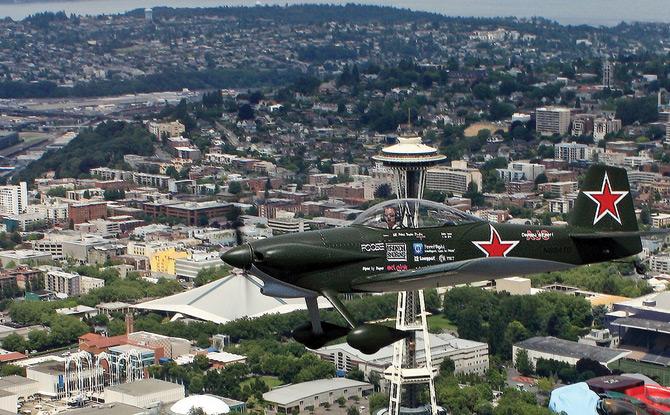 Taylor De Lay circles the Space Needle in Seattle in his Van's RV–4
Taylor De Lay circles the Space Needle in Seattle in his Van's RV–4
17-year-old circles the United States
Taylor De Ley of Yorba Linda, California, may be only 17, but he has already focused on a professional pilot career and completed a 10,492-nautical-mile solo flight to the four corners of the nation. He now has 340 total flying hours.
He dedicated the flight to giving fellow teens who are “stuck playing video games” a taste of the flying adventure through his reports on Facebook, and through the news reports written about him. He also spoke to Experimental Aircraft Association chapters at several stops on the multi-week trip.
The trip took 71.9 flying hours, nearly the exact number he planned. Planning started four years ago after he read Stephen Coonts’ The Cannibal Queen. He and his father, Luc, also a pilot, completed a Van’s RV–4 airplane kit bought for $38,000, equipped it with a Superior XP-360 180-horsepower engine, and never looked back. His mother, Inger, may have rethought the decision over and over, but allowed the trip. The family is originally from Belgium.
De Ley made some airline career contacts at his home airport where he waxed airplanes to pay for the trip, Corona Municipal, but airline jobs tie for first place with flying for FedEx or United Parcel Service. He has chosen to study accounting in college as a fallback career, if needed. The contacts he made at Corona included his flight instructor, Dave Stevenson, who helped him experience a Boeing Stearman, a Piper Super Cub, and 40 other models. He began his career in gliders while too young to become a private pilot.
The trip went without problems from weather, airspace, or mechanical issues. All he did was change the oil twice. While he had contingency plans for weather, he needed them only once for his one-day weather delay in Maine. Flying friends across the country let him stay at their homes.
As for airspace, he handled it like a pro, although he found the airspace around Washington, D.C., to be “intimidating.” It took a great deal of maturity to make the trip, and that’s not a problem for De Ley.
“He’s 17, going on 45,” his father, Luc, told several news outlets.
“I’m just me,” De Ley countered when asked about his father’s comment. “It is what it is.” Yet, listen to this from the youngster: “Seniors in high school have no idea what they want to do. It’s ridiculous.” It may come as no surprise that his friends can’t relate to such a strong and focused passion for flying. “My friends are not interested in it,” he said. If it is up to him, he’ll do what he can to change that.
He has a head start on the goal.
Test Pilot 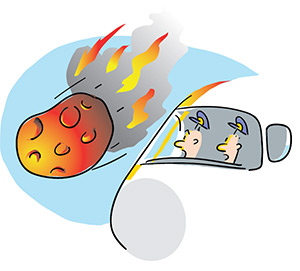
By Barry Schiff
- From reader John Schmidt: What country is always on Greenwich Mean Time (UTC or Zulu time)?
- A pilot lands on a long runway at night. During the landing roll, he crosses a row of pulsing white lights embedded in the runway. What is the significance of these lights?
- What famous American wrote what is considered to be America's first airmail letter?
- A parcel of air has a temperature of 70 degrees Fahrenheit and a relative humidity of 50 percent. If its temperature is raised to 90 degrees and no water vapor is added to or removed from the parcel, its relative humidity will be
a. 100 percent.
b. 75 percent.
c. 50 percent.
d. 25 percent. - From reader Ian Kluft: True or False: At least one airline crew has received an in-flight warning of an asteroid on a collision course with Earth.
- True or False: A pilot about to land on an unusually wide runway at night is most likely to perceive that he is closer to the runway than he really is and flare prematurely (while too high).
- From reader Brian Schiff: A pilot is cruising over Kansas at an assigned altitude of 10,000 feet, but the altitude indicated on his GPS is 9,250 feet. This flight is likely occurring in the
a. autumn.
b. spring.
c. summer.
d. winter. - The lomcovák, an aerobatic maneuver during which an airplane seems to be tumbling out of control, is a Czechoslovakian word derived from the name or word that means or represents
a. a large, stiff drink.
b. a migraine headache.
c. a town in Czechoslovakia (now Slovakia).
d. its creator's mother-in-law.
Aerial chase nabs Arkansas burglary suspects
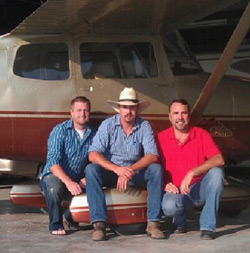 Barry Jackson, Steven Lynn, and David Hudson
Barry Jackson, Steven Lynn, and David Hudson
David Hudson has seen it all working the scenes of car wrecks and other emergencies on his job as a medevac helicopter pilot. But a flight in a borrowed Cessna 172 now rates as "the wildest experience I've ever had," he said.
Local police are calling the flight that began as a pleasure outing on August 23 the "eye in the sky" that helped them apprehend two burglary suspects. And a first-time passenger aboard the Cessna is very glad that he asked Hudson to point out his Craighead County, Arkansas, home from the air.
Hudson, of Jonesboro, and two buddies had been planning a fishing trip to a favorite spot on the Mississippi River about 60 miles away near Memphis, Tennessee. They wondered if the river might be too low to make the trip worthwhile. Hudson, a 6,000-hour working pilot, suggested that they use a Skyhawk owned by his friend Barry Jackson to fly over and check river conditions. They departed from the Jonesboro Municipal Airport.
Passenger Steven Lynn made a request familiar to many pilots giving sightseeing flights: Lynn asked if Hudson could fly them over Lynn's house.
Lynn had some trouble orienting himself in the air, so he didn't recognize his property right away. But Hudson showed Lynn where the house was. He also pointed out a white pickup truck parked nearby.
"There are some guys loading up some stuff in a truck right in your driveway," he said.
Under the circumstances, Hudson considers Lynn's reaction pretty normal.
"He started freaking out, like anybody would," the pilot said.
At first Lynn wanted Hudson to land on the road. Hudson rejected that plan. Then Lynn began making calls on his cell phone, to police and to an uncle who lives a short distance away. As the Cessna circled overhead, Lynn's uncle pulled up in the driveway and confronted the strangers.
The men on the ground tried to talk their way out of the situation until Lynn's uncle informed them that Lynn was watching the scene unfold from the Skyhawk, which was circling at about 1,800 feet.
That's when the men started throwing the heavy air conditioning units they had loaded from their vehicle. Then they "went out across the yard, through a ditch onto the gravel road, and just took off," Hudson recalled.
The fishermen gave chase—after Hudson overtook the truck, he slowed the airplane enough so that eventually "we were staying with them really good, running side by side." (That meant adding carb heat, setting power at 2,000 rpm, and selecting 20 degrees of flaps. Hudson also descended to 1,000 feet, an appropriate altitude for ground-reference maneuvers). They also captured cell phone video of the chase.
The alleged burglars could run, but they couldn't hide from the Skyhawk that was flying above the flat farm country. Even when the getaway vehicle passed a rare tree line, the airborne pursuers had no trouble keeping the fleeing pickup in sight.
Lynn relayed the truck's turns—and a stop-sign violation—to police converging from all directions. Two state troopers and four county police stopped the suspects on Highway 158, about six miles from the airport.
Hudson landed the Cessna in Jonesboro and quickly tied down the aircraft. Lynn's vehicle was parked at the airport. They jumped in and headed for the spot. When Hudson and Lynn got there, "They still had them there in the back of the cop car," Hudson said.
According to news reports, police charged two Jonesboro men with residential burglary and theft of property. Police credited the "eye in the sky" with helping them nab the suspects.
It all happened so fast that the possibility never occurred to Hudson that the men down below might be armed. Missing from Lynn's home, but not found in the truck by police, was a fully loaded automatic rifle, Hudson said.
Hudson said he has seen a lot in his work—but this was different. When flying an evacuation mission, you experience an initial rush of excitement after which "it all cools down and you're just doing your job."
This time, Hudson thinks he was probably influenced by the reactions of his nonpilot passengers, once the three men realized that they had happened over a crime scene.
"The adrenaline got to me too. It really did," he said. "Immediately you're like, 'Oh, man, get those guys.'"
—Dan Namowitz
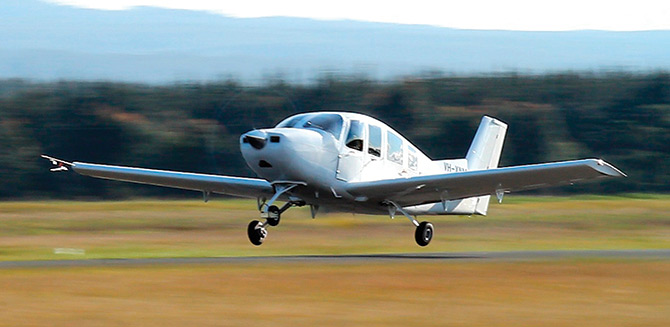
Aircraft developed in India flies in Australia
In what is claimed to be the first joint public and private development effort, a prototype fixed-gear single-engine aircraft designed in India has flown in Australia. It was built by GippsAero, the Australian manufacturer of the Airvan, a company owned since 2010 by Mahindra Aerospace of Mumbai, India.
The aircraft flew September 1, but the flight was not announced until September 14. The all-metal five-place aircraft, powered by a Lycoming IO-540 engine, is designated the C-NM5. It was designed by India's National Aerospace Laboratories and Mahindra Aerospace. It was built in 10 months in Australia.
Additional flights have taken place since September 1. The aircraft will be certified in a number of countries and sold worldwide.
GippsAero did not include performance or technical details in its initial announcement. A report in the Financial Times said the aircraft would cost between $350,000 and $400,000. The Times said there are plans to produce two-seat, eight-seat, 10-seat, and 18-seat aircraft in the future. Aviation analysts interviewed for the Times report expressed doubt that India has the airport infrastructure to support travel by small aircraft.
Slovenian company promises electric airplane
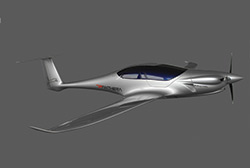 Pipistrel, a Slovenian company now building a 107,000-square-foot plant in Italy, promises by 2014 you will be able to buy its proposed four-seat Panthera with three interesting propulsion options: gasoline-powered, hybrid-electric, and all-electric.
Pipistrel, a Slovenian company now building a 107,000-square-foot plant in Italy, promises by 2014 you will be able to buy its proposed four-seat Panthera with three interesting propulsion options: gasoline-powered, hybrid-electric, and all-electric.
The prices range from $400,000 to $600,000, and include a fully certified FAA Part 23 IFR, long range, four-place aircraft powered by the Lycoming IO-390 210-horsepower engine. Hybrid and all-electric options—found near the $600,000 end of the price range—will be flown in the Experimental aircraft category. At the lower end of the price range is a VFR-only Panthera also powered by the Lycoming IO-390.
The question is, can Pipistrel pull off the hybrid and all-electric options? At the moment, battery technology doesn't exist for a practical all-electric aircraft, according to large aircraft manufacturers. That said, Pipistrel has won competitions for fuel-efficient aircraft and has 1,000 aircraft in the fleet—nearly all in Europe.
The company claims two dozen orders for its gasoline-powered Panthera. Deposits can be returned if the customer does not like the demonstrator. The company will offer a turbocharged variant as well.
Seattle Aviation High School produces results
Seattle's Aviation High School, located across the street from the Boeing Museum of Flight, has sent one of its first graduates from the class of 2008 into the aviation industry, after that student graduated from college. It works.
Natalie Nason has joined the marketing and sales team at Dynon, manufacturer of Experimental and light sport glass cockpits, after graduating from Rocky Mountain College magna cum laude. She entered Aviation High School in 2004.
Aviation High School, which teaches the history, math, science, and business of aviation, has now broken ground for a new $43.5 million facility. In response to a $3 million gift from James and Sherry Raisbeck, it will be called the Raisbeck Aviation High School. Nason spoke at the dedication ceremonies.
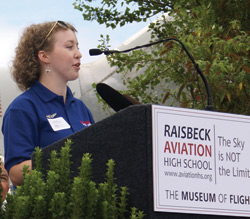 Nason's focus on aviation dates back to her childhood. Raised at Crest Airpark near Seattle, she attended the EAA Air Academy and earned her pilot certificate at 18. She assisted 20 at-risk kids with building an airplane from a kit at Boeing Field.
Nason's focus on aviation dates back to her childhood. Raised at Crest Airpark near Seattle, she attended the EAA Air Academy and earned her pilot certificate at 18. She assisted 20 at-risk kids with building an airplane from a kit at Boeing Field.
"We are pleased to hire an exceptional young pilot who has such an impressive combination of education and practical experience," said Robert Hamilton, director of marketing and sales at Dynon. "The Aviation High School provided her with invaluable insight and knowledge for a career in the aviation industry. Natalie has supplemented that with university training and a variety of hands-on experiences at Boeing Field. With her background and high energy level she is perfectly suited to work with the worldwide customer base for Dynon Avionics."
Aerobatic pilot Betty Skelton, 'First Lady of Firsts,' dies
Betty Skelton Erde, known as the "First Lady of Firsts," died on August 31 at her home in The Villages, Florida. She was 85.
Born in Pensacola, Florida, on June 28, 1926, Skelton played with model airplanes as a child and would watch Stearmans flying overhead from nearby Pensacola Naval Air Station. She soloed (illegally) at age 12, according to a biography provided by the National Aviation Hall of Fame. She soloed legally when she turned 16, and at age 17 had acquired the required number of hours to qualify for the Women Airforce Service Pilots, but the WASP was disbanded by the time Skelton had turned 18 years and six months, the required minimum age to join.
Skelton flew her first aerobatics performance in a borrowed Fairchild PT–19 and began her professional aerobatic career in 1946, flying a 1929 Great Lakes 2T1A biplane. Perhaps her best-known aircraft was the Pitts Special S–1C that she purchased in 1948 and named Li'l Stinker. Li'l Stinker is currently on display at the National Air and Space Museum's Steven F. Udvar-Hazy Center in Virginia.
Among her many aviation accomplishments, Skelton became the first woman to perform an inverted ribbon cut 10 feet from the ground.
Jim Cunningham, author of Bill Brennand: Air Racing and Other Aerial Adventures, said Skelton was good friends with air race and airshow legends Brennand and Steve Wittman in the late 1940s.
"She told Bill that she wanted to do an inverted ribbon cut for her airshow routine in her Pitts Special. On her first attempt, with Bill holding one of the ribbon poles, she got so low that she flew under the ribbon," Cunningham said.
"On another attempt she was down on the deck, inverted, when her engine quit. She only had an instant to identify the problem and apply positive correction, and she did, rolling upright and landing uneventfully," Cunningham said. "After displaying her superior piloting ability in that incident, she displayed her superior pilot judgment and decided her airshow routine did not need such a dangerous maneuver."
Skelton won the Feminine International Aerobatic Championship in 1948, 1949, and 1950. In 1949, she set the world light plane altitude record in a Piper Cub, reaching 25,763 feet. In 1951, she set that record again, this time reaching 29,050 feet.
In 1959, Skelton participated in physical and psychological tests given to the original Mercury 7 astronauts. Reportedly, she had no illusions that she would be chosen to participate in the program, but her involvement got her on the cover of Look magazine.
In addition to her aviation accomplishments, Skelton was involved in stock car racing, was a test driver, and became an advertising executive with General Motors. She was inducted into the National Aviation Hall of Fame in 2005.
"It was no wonder that GM hired her as an advertising executive," Cunningham said. "When she and Bill [Brennand] were on the airshow circuit in the late 1940s, she would go into a town hosting an airshow several days in advance and get the mayor to proclaim an 'aviation day' for the city and announce a 'free' airshow. Admission was indeed free, but there were parking fees for cars and seats. She also would get local businesses to run ads in the town newspapers that would include things like 'Good luck airshow pilots!' and put up signs for the show. Tons of advertising for the show—and it didn't cost her or the performers a dime."
Skelton enjoyed fast cars into her 80s, and at age 82 was waiting on GM to modify her latest Corvette (she had owned 10).
—Jill W. Tallman
LoPresti introduces 'Never Flat' tire
Calling it the first of its kind, LoPresti Aviation Engineering is developing an aircraft tire the company says will never go flat.
The NeverFlat Lifesaver has a band of carbon fiber embedded in the tire. CEO Rj Siegel said, "It's just about impossible to puncture this tire and even if you could, it still wouldn't go flat. It's an unpressurized system with load and suspension characteristics matched to the aircraft's needs."
The first tire is designed for the performance characteristics of the Cirrus SR20 and SR22, LoPresti said. "Using this new proprietary technology we've seen improved tire performance in all measurable areas. Wear, traction and rolling resistance," Siegel said.
The tire is being offered with a 10-year warranty against a flat tire. The tire is in its final development stages and should be available on the Cirrus models beginning in December. —Ian J. Twombly
Flying car market gains competitors
There already is competition in the flying car market, despite there being none ready for delivery. First, there is the Terrafugia flying car near Boston that has flown, with more flights to come in 2012. Then came news that Burt Rutan designed a flying car long ago that has now flown in California. That one is in limited development at Rutan's old company, Scaled Composites. Next comes the Carplane, a German project that hasn't flown yet, but looks similar to the Rutan project.
Already there are competing claims, with Carplane manager John Brown suggesting Rutan's measurements are off, and Rutan saying he will wait for a fly-off competition between the two.
The Carplane is not expected to fly for four years, but there are models of it. It will not be shown publicly until it is ready.
"Nothing like this aircraft has been done before," Brown said. "So I'm very reluctant to estimate how long it might take. We usually answer '2015 at the earliest.' What's taking [the] most time is calibrating the aerodynamic switch-over from positive lift to negative lift. Every time we optimize for road mode, it affects air mode and vice versa. The moveable surfaces (canard, wings, empennage) aren't so much of a problem. It's the remainder of the vehicle which needs to be optimized in a 'grand compromise' for both modes. We're also tweaking the propulsion systems, thermal management, and overall weight."
The wings are electrically folded by the owner.
SJ30 jet to continue
After months of silence from the new owner of the SJ30 jet type certificate, manufactured in the past by Sino Swearingen and Emivest, Metalcraft Technologies says the company will continue under the name SyberJet. The company uses the name MT, LLC.
SyberJet officials have moved the Martinsburg, West Virginia, assembly line to its facilities in Cedar City, Utah, and is continuing operations in a remaining San Antonio building.
Mark Fairchild, the company spokesman and test pilot under past owners, is now the SyberJet general manager in San Antonio. "SyberJet has a solid operating plan to deliver new SJ30s to the world marketplace," Fairchild said. "I look forward to providing more people the unique opportunity to experience the high performance capability that SJ30 affords its owners and operators."
TEST PILOT ANSWERS
- Nope, it's not England, which goes on daylight saving time during the summer. Iceland is on GMT all year long.
- These land-and-hold-short lights are installed across certain runways approved for land-and-hold-short operations (LAHSO) at the hold-short point. They help pilots to avoid tangling with aircraft taking off or landing on a crossing runway.
- John Pierre Blanchard carried George Washington's (obviously) handwritten letter during a balloon flight from Philadelphia in 1793.
- d. For every 20 degrees that temperature increases, relative humidity decreases by 50 percent. Conversely, for every 20-degree decrease, relative humidity doubles.
- True. On October 6, 2008, KLM Flight 592 was advised that a small asteroid, 2008 TC3, might become visible as it entered the Earth's atmosphere. Avoidance vectors were not provided.
- True. Conversely, a pilot about to land on an unusually narrow runway can perceive that he is higher than he really is and touch down without having flared sufficiently to avoid a hard landing.
- d. When temperatures are colder than standard, true altitude is lower than indicated altitude.
- a. Some suggest that consuming a lomcovák is similar to what it feels like to perform one, or that such a drink might be needed to develop the courage to perform one for the first time.


